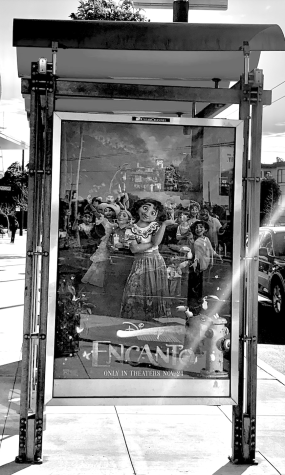How “Encanto” empowers: the importance of representation in media

On Rotten Tomatoes, “Encanto” has a 91% rating on the tomatometer, 195 reviews, a 93% audience score, and over 2500 verified ratings. Encanto’s hit song “We Don’t Talk About Bruno” has been number one on the Billboard Top 200 in four separate weeks, beating Disney’s famous “Let it Go” which only made it to number five.
The popularity of “Encanto” is a huge milestone for Disney. Historically, representation of racial minorities, women and LGBTQ+ characters has been scarce. The creation of “Encanto” could signify a change in Disney’s diversity issue. The movie has been hugely influential for both young and old viewers of underrepresented groups alike.
“Disney’s run into a lot of problems with just kind of combining cultures into their own fantasy culture in a weird feeling way,” said Hannah Tawadrous ‘22. In contrast to these common narratives, “Encanto” tells the story of a Colombian family. The movie features a young girl, Mirabel, who is trying to find her place in her family and town. Her grandmother, Abuela Alma, had to flee her home and re-establish herself and her family in Colombia. “Encanto” details the struggles that Mirabel – and her siblings – experience due to the pressure they feel to perform for their family.
Katina Papson-Rigby, the director of Service Learning at Urban, said “[for] a young Latinx child in the United States, at a time when we’re still dealing with so much discrimination, to see Lin Manuel Miranda as a successful musician and a narrative of a family that’s not perfect, but also is so beautiful… is special.” For young children, or even fully grown adults, being able to see their identities reflected in the media they consume shows that they are not alone.
Papson-Rigby said, “I was overwhelmed with the truth of it, and the accuracy of it… I felt shocked by it in a wonderful way.” After watching the movie she immediately stepped out of the theater and said to her husband, “We have to show my mom and my cousins.” For Papson-Rigby, “Encanto” gave her family the ability to talk about ways they could learn and grow from each other, as well as an appreciation for how amazing their family is.
People of color in the media are underrepresented, and if they are represented, they are often stereotyped. In spite of this, Tawadrous said, “There were a couple of scenes [in “Encanto”] that were just so painfully accurate, like the dysfunctional family dinner.”
In a Common Sense Media report, it was discovered that even though 18.5% of the United States population is Latinx, only around 5% of characters with speaking roles in the media are Latinx. In the same report, it was found that in children’s media (ages 2-13), characters of color are more likely to be portrayed as violent, and female characters of color have a higher likelihood of being sexualized.
“I feel like every other Disney [movie] I’ve seen is mostly white people,” said Yosi Colin ‘23, “[Even] “Pocahontas” is kind of twisted. It’s not really the true story behind it.” Stereotypes of minority groups that are constantly reinforced in the media can lead audiences to believe the stereotypes as fact.
For children of color, seeing negative representations of themselves in the media can impact their personal identity. “Encanto” stands in opposition to the many stories with solely white heroes and white families. As Colin said, “Seeing that what you do in your daily life is represented or that other people do that in their life makes you feel heard and seen.”











